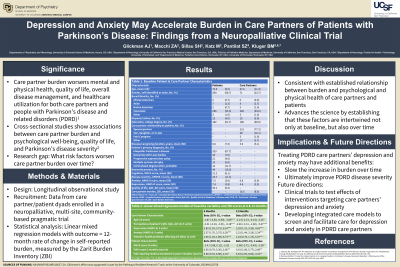Psycho-Oncology and Palliative Care
Session: Poster Session
(119) Depression and Anxiety May Accelerate Burden in Caregivers of Patients with Parkinson's Disease: Findings from a Neuropalliative Clinical Trial

Trainee Involvement: Yes
- AG
Amanda Glickman, MD (she/her/hers)
PGY4 Resident
University of Colorado School of Medicine
AURORA, Colorado, United States - ZM
Zachary A. Macchi, MD
Assistant Professor
University of Colorado School of Medicine
Aurora, Colorado, United States - SS
Stefan Sillau, PhD
Research Instructor
University of Colorado School of Medicine
Aurora, Colorado, United States - MK
Maya Katz, MD
Associate Professor
Stanford University School of Medicine
San Francisco, California, United States 
Steven Pantilat, MD
Professor; Chief, Division of Palliative Medicine
University of California San Francisco
San Francisco, California, United States- BK
Benzi Kluger, MD, MS, FAAN
Professor
University of Rochester Medical Center
Rochester, New York, United States
Presenting Author(s)
Co-Author(s)
Background/Significance: Informal caregivers provide vital support for patients with Parkinson’s disease and related disorders (PDRD). Higher rates of caregiver burden negatively impact both caregivers’ and patients’ mental and physical health, quality of life, and overall disease management (1). Cross-sectional studies have demonstrated associations between PDRD caregiver burden and baseline caregiver and patient psychological well-being, quality of life, and disease severity (2). However, it is crucial to understand what risk factors may worsen PDRD caregiver burden over time, especially given the progressive disease course. This longitudinal study addresses this gap by identifying predictors of accelerated PDRD caregiver burden. Conclusions/Implications: Depression and anxiety are potentially modifiable factors that can be both addressed in clinical practice by psychiatrists treating PDRD caregivers, as well as serve as intervention targets for future studies.
Methods: This longitudinal observational study used data previously collected from PDRD patient-caregiver dyads who participated in a multi-site community-based pragmatic stepped-wedge trial (ClinicalTrials.gov NCT03076671). Linear mixed regression models were used to investigate factors associated with the 12-month rate of change in caregiver burden as measured by the Zarit Burden Inventory (ZBI). Models were adjusted for treatment group, disease severity, and primary diagnosis. All participants gave written informed consent for the research protocol, which was approved by the Colorado Multiple Institutional Review Board.
Results: Data were collected from 300 participant dyads. Caregivers were 76% women, with a mean age of 67.6 years (SD 11.3); parent trial treatment arm was not correlated with ZBI score at 12 months or the change in ZBI score from baseline to 12 months. Caregiver characteristics predictive of accelerated burden over 12 months included higher depression (ß=2.29 (per 3 units on the Hospital Anxiety and Depression Scale), 95%CI 1.31, 3.26, p< 0.001), anxiety (ß=2.31 (per 3 units), 95%CI 1.44, 3.18, p< 0.001), and younger age (ß=1.14 (per 10 years), 95%CI 0.14, 2.14, p< 0.05). Patient characteristics included cognitive impairment (ß=-2.08 (per 5 units on the Montreal Cognitive Assessment), 95%CI -3.72, -0.44, p< 0.05) and falls in the past 3 months (ß=3.41 (yes vs no), 95%CI 1.06, 5.77, p< 0.01), especially where falls warranted medical treatment (ß=5.43 (yes vs no), 2.05, 8.82, p< 0.01).
Discussion: Caregiver depression and anxiety, along with patients’ motor deterioration and cognitive dysfunction, were drivers of accelerated caregiver burden in our population. This builds on prior knowledge of the relationship between burden and psychological and physical health of both caregivers and patients, establishing that these factors are intertwined not only at baseline but also over time.
References:
1. Edwards NE, Ruettiger KM. The influence of caregiver burden on patients' management of Parkinson's disease: implications for rehabilitation nursing. Rehabilitation nursing: the official journal of the Association of Rehabilitation Nurses 2002;27(5):182-186, 198.
2. Martinez-Martin P, Forjaz MJ, Frades-Payo B, et al. Caregiver burden in Parkinson's disease. Movement disorders: official journal of the Movement Disorder Society 2007;22(7):924-931; quiz 1060.

